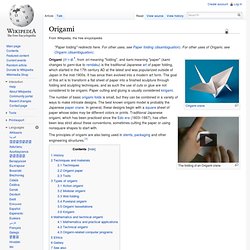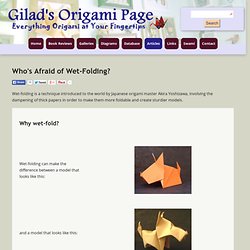Zoom
Trash

Origami - Wikipedia, the free encyclopedia - Minefield. The folding of an Origami crane Origami (折り紙?

, from ori meaning "folding", and kami meaning "paper" (kami changes to gami due to rendaku) is the traditional Japanese art of paper folding, which started in the 17th century AD at the latest and was popularized outside of Japan in the mid-1900s. It has since then evolved into a modern art form. The goal of this art is to transform a flat sheet of paper into a finished sculpture through folding and sculpting techniques, and as such the use of cuts or glue are not considered to be origami. Paper cutting and gluing is usually considered kirigami. The principles of origami are also being used in stents, packaging and other engineering structures.[1] History There is much speculation about the origin of Origami. In China, traditional funerals include burning folded paper, most often representations of gold nuggets (yuanbao). The earliest evidence of paperfolding in Europe is a picture of a small paper boat in Tractatus de sphaera mundi from 1490.
Wet-folding. Wet-folding bull Wet-folding is an origami technique developed by Akira Yoshizawa that employs water to dampen the paper so that it can be manipulated more easily.

This process adds an element of sculpture to origami, which is otherwise purely geometric. Wet-folding is used very often by professional folders for non-geometric origami, such as animals. Wet-folders usually employ thicker paper than would usually be used for normal origami, to ensure that the paper does not tear. One of the most prominent users of the wet-folding technique was Éric Joisel, who specialized in animals, people, and mythological creatures such as fairies. The process of wet-folding allows a folder to preserve a curved shape more easily. Notes and references[edit] See also[edit] Papier-mâché External links[edit] Gilad's Origami Page - Wetfolding How-to guide - Minefield. Fold the model as you usually do, but with one exception.

In regular folding, you may be used to putting creases in using your fingernails: In wet-folding, don't put such strong creases. Use the pads of your fingers instead. After the first few folds, try making most folding "in the air", not using a table. If you feel the paper starting to get dry and stiffen while folding, use the cloth or spray-bottle to add some moisture, but try to not over-do it. RARE:How to Make a Transforming Origami Spikey Ball - YouTube - Minefield. Origami Small Triambic Icosahedron (long version) - YouTube - Minefield. Sonobe module. Instuctions for making this model Below is the Sonobe unit, designed by Mitsonobu Sonobe, which I learned from Kazuyo Inoue.

Above is the capped icosahedron which she made for me from this unit; you need to make about 30 units for this, but you only need six if you want to make a cube. Since this must be very well known, I'm only putting a very brief picture of how to make it. The second line of instructions gives a little more detail for the last step. Just in case you want more details than above, you can find some more diagams here and here. Kazuyo first showed me a kind of stellated icosohedron made from this unit; and there are lots more things to be made from it. Sonobe links. Re: How to make an Origami Kusudama - YouTube - Minefield. Origami Small Triambic Icosahedron (Sonobe) - YouTube - Minefield.